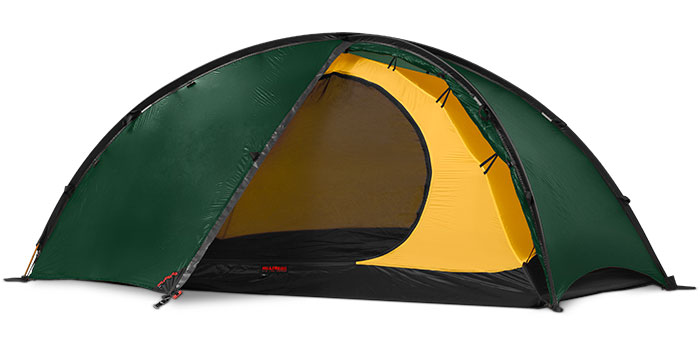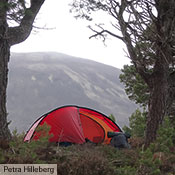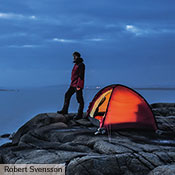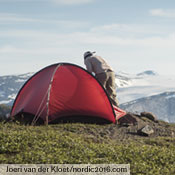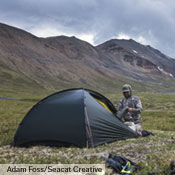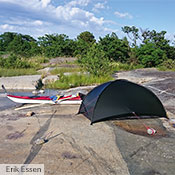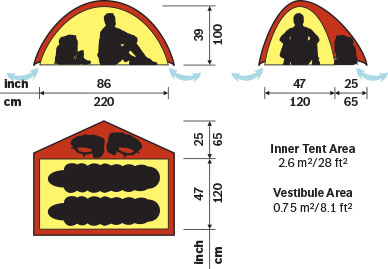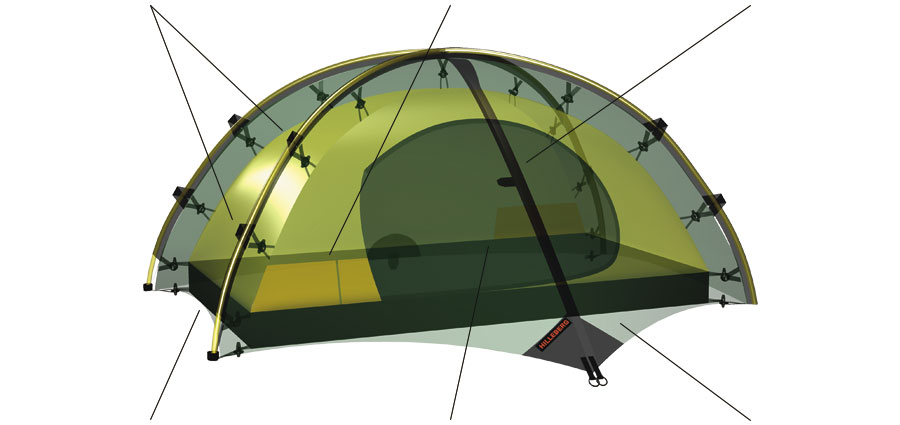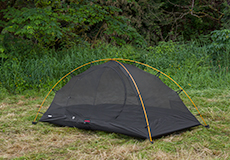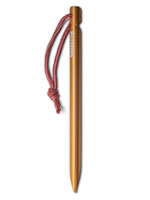When we began developing what became the Niak, two things guided the process: our Red Label, one-person tent Unna, which provided the Niak's general shape; and our Yellow Label Enan solo tent, whose success indicated that there was a good opportunity for a very light, self-supporting three-season tent as a kind of complement to it.
"The Unna has been popular for many years," says Bo Hilleberg. "Since it does not have a vestibule, its inner tent is bigger. It is often used by two people, who, of course, would like a vestibule." For the Niak, we thought the simplicity and roominess of the Unna would be an excellent template, but with the addition of a vestibule.
At the same time, our experience with the Enan strengthened our convictions about our organizing principle of "the right kind of light weight" in a tent. We know that people are very weight conscious, but we are not willing to compromise a tent model's necessary strength for its intended purpose by making it lighter just to make it more popular. We knew that a self-supporting tent that was strong enough for full three-season use, but was still quite light, would be appealing to many adventurers.
As with the Enan, we could have made the Niak lighter, but it would not have satisfied our goals. And at 1.7 kg (3 lbs 12 oz), it is remarkably light. We used the same Kerlon 1000 outer tent fabric and 9 mm poles found in all of our Yellow Label tents, and incorporated catenary patterning into the bottom of the outer tent walls for full-time air flow (something we have also included in our 2017 redesign of the Anjan, Anjan GT and Rogen models). We tested the Niak extensively in the year and a half prior to its introduction, with testers spending over 250 nights in the tent, in the US, Scandinavia and other parts of Europe.
We originally envisioned the Niak as a "1.5" tent: ideal for a solo traveler who wants maximum room, but big enough to use, if necessary, for two people. "Many years ago, Petra and I were out on a ski tour soon after we introduced the Unna," says Bo. "We met a couple of big guys who were raving about our new two-person tent that they had just stayed in. We were confused, since we didn't have a new two-person tent out. They were talking about the Unna, and they were very happy with it! This story stayed with me, and the idea of a roomy, light tent that could be used by either one or two people contributed to the first prototypes of the Niak." But after more testing, we realized that we could very easily make the Niak wider - truly wide enough for two people - and still keep the weight down. So the Niak, originally conceived as a lightweight solo tent for those who prize comfort as well as low weight, became the two-person Niak.
However, its single door and lengthwise vestibule make it somewhat less comfortable than our other two person models. "Years ago, we had a two-person, all-season tent - also called the Niak - that had a design and floor plan much like the new one. But it was a bit too heavy for its size, so we took it out of the line," says Bo. "Today's Niak is quite popular because of its weight, and while it's designated as a two-person tent, I think more people buy the Niak as a solo tent, but with the idea that it could be used for two. Two full sized people going on a long trip…one of our other two-person tents would be a better choice, unless they are very, very close!"
That said, for those pairs wanting a strong, very light three-season solution, the Niak works very well. One of our staff, who is 196 cm (6 ft 5 in) tall, and his wife, who is 176 cm (5 ft 9 in), have used the Niak often for some of their trips. And Emma Forsell and Linnéa Grahn of Mind for Adventure used the Niak quite happily on their fully self-supported run along the northwest coast of Scotland from Cape Wrath in the north to the Mull of Galloway in the south. They covered nearly 900 km (560 miles) in 24 (very wet) days, and loved their Niak.
When we began developing what became the Niak, two things guided the process: our Red Label, one-person tent Unna, which provided the Niak's general shape; and our Yellow Label Enan solo tent, whose success indicated that there was a good opportunity for a very light, self-supporting three-season tent as a kind of complement to it.
"The Unna has been popular for many years," says Bo Hilleberg. "Since it does not have a vestibule, its inner tent is bigger. It is often used by two people, who, of course, would like a vestibule." For the Niak, we thought the simplicity and roominess of the Unna would be an excellent template, but with the addition of a vestibule.
At the same time, our experience with the Enan strengthened our convictions about our organizing principle of "the right kind of light weight" in a tent. We know that people are very weight conscious, but we are not willing to compromise a tent model's necessary strength for its intended purpose by making it lighter just to make it more popular. We knew that a self-supporting tent that was strong enough for full three-season use, but was still quite light, would be appealing to many adventurers.
As with the Enan, we could have made the Niak lighter, but it would not have satisfied our goals. And at 1.7 kg (3 lbs 12 oz), it is remarkably light. We used the same Kerlon 1000 outer tent fabric and 9 mm poles found in all of our Yellow Label tents, and incorporated catenary patterning into the bottom of the outer tent walls for full-time air flow (something we have also included in our 2017 redesign of the Anjan, Anjan GT and Rogen models). We tested the Niak extensively in the year and a half prior to its introduction, with testers spending over 250 nights in the tent, in the US, Scandinavia and other parts of Europe.
We originally envisioned the Niak as a "1.5" tent: ideal for a solo traveler who wants maximum room, but big enough to use, if necessary, for two people. "Many years ago, Petra and I were out on a ski tour soon after we introduced the Unna," says Bo. "We met a couple of big guys who were raving about our new two-person tent that they had just stayed in. We were confused, since we didn't have a new two-person tent out. They were talking about the Unna, and they were very happy with it! This story stayed with me, and the idea of a roomy, light tent that could be used by either one or two people contributed to the first prototypes of the Niak." But after more testing, we realized that we could very easily make the Niak wider - truly wide enough for two people - and still keep the weight down. So the Niak, originally conceived as a lightweight solo tent for those who prize comfort as well as low weight, became the two-person Niak.
However, its single door and lengthwise vestibule make it somewhat less comfortable than our other two person models. "Years ago, we had a two-person, all-season tent - also called the Niak - that had a design and floor plan much like the new one. But it was a bit too heavy for its size, so we took it out of the line," says Bo. "Today's Niak is quite popular because of its weight, and while it's designated as a two-person tent, I think more people buy the Niak as a solo tent, but with the idea that it could be used for two. Two full sized people going on a long trip…one of our other two-person tents would be a better choice, unless they are very, very close!"
That said, for those pairs wanting a strong, very light three-season solution, the Niak works very well. One of our staff, who is 196 cm (6 ft 5 in) tall, and his wife, who is 176 cm (5 ft 9 in), have used the Niak often for some of their trips. And Emma Forsell and Linnéa Grahn of Mind for Adventure used the Niak quite happily on their fully self-supported run along the northwest coast of Scotland from Cape Wrath in the north to the Mull of Galloway in the south. They covered nearly 900 km (560 miles) in 24 (very wet) days, and loved their Niak.

 Cart
Cart






